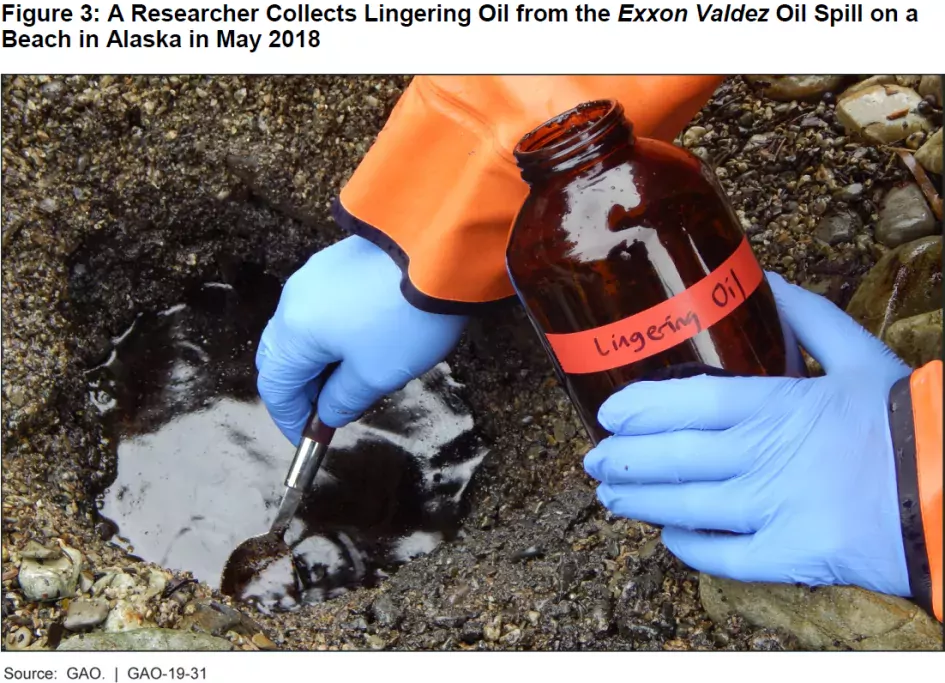30 Years after Exxon Valdez, 9 Years after Deepwater Horizon: What We Found
Thirty years ago this month, the Exxon Valdez oil tanker hit a reef and spilled millions of gallons of crude oil into Prince William Sound, Alaska. In April 2010, the Deepwater Horizon offshore drilling rig exploded and sank, causing a massive oil spill in the Gulf of Mexico.
In today’s WatchBlog, we check in on the status of restoration and oil pollution research efforts. Read on and listen to our podcast with Frank Rusco, a director in our Natural Resources and Environment team, to learn more.
Who foots the bill for oil spills
Following the Exxon Valdez spill, Congress enacted the Oil Pollution Act of 1990, which
- established a “polluter pays” system, whereby the responsible party must pay for oil spill cleanup costs and damages,
- allowed federal, state, and other officials to act on behalf of the public as trustees to recover those costs and manage cleanup and restoration efforts, and
- created a multi-agency committee to coordinate oil pollution research.
In the wake of both oil spills, federal and state trustees settled with responsible parties to resolve certain claims, resulting in
- $900 million to a restoration trust fund for damage assessment, cleanup, litigation, and restoration after the Exxon Valdez spill, and
- $8.8 billion to a restoration trust fund to address natural resource damages from the Deepwater Horizon spill.
Status of restoration efforts
Here’s what we found when we checked in on the status of restoration efforts.
Exxon Valdez
As of January 2018, the trustee council had used about 86% of the Exxon Valdez restoration trust fund, mostly on habitat protection and restoring damaged natural resources.
All but 5 of the 32 damaged natural resources and human services had recovered or were recovering.
However, the Pacific herring, for example, hasn’t recovered yet. Further, in May 2018, we watched researchers excavate 3 pits in the spill area—30 years later, there was still oil below the beach’s surface.
Deepwater Horizon
As of December 2017, the trustee council had used 13% of the Deepwater Horizon restoration trust fund, mostly on habitat protection, enhancing recreation, such as building boat ramps and other recreational facilities. Most of the restoration activities are still being planned.
Oil spill research
From FY11 through FY17, agencies from the research committee have funded over 100 oil spill research projects per year. These projects focus on preventing, preparing for, responding to, and restoring the environment after oil spills.
Agency officials told us that the committee has helped increase communication and understanding of the oil spill research community, identify research gaps, and leverage resources. However, we found that the interagency committee does not coordinate with relevant trustee councils. In fact, some trustee council members didn’t know the committee existed.
We recommended that the research committee coordinate with the trustee councils to help the groups share information and leverage resources. To learn more
Comments on GAO’s WatchBlog? Contact blog@gao.gov.
GAO Contacts
Related Products

GAO's mission is to provide Congress with fact-based, nonpartisan information that can help improve federal government performance and ensure accountability for the benefit of the American people. GAO launched its WatchBlog in January, 2014, as part of its continuing effort to reach its audiences—Congress and the American people—where they are currently looking for information.
The blog format allows GAO to provide a little more context about its work than it can offer on its other social media platforms. Posts will tie GAO work to current events and the news; show how GAO’s work is affecting agencies or legislation; highlight reports, testimonies, and issue areas where GAO does work; and provide information about GAO itself, among other things.
Please send any feedback on GAO's WatchBlog to blog@gao.gov.





